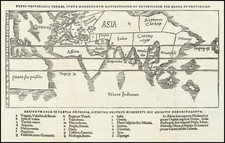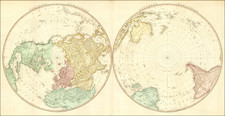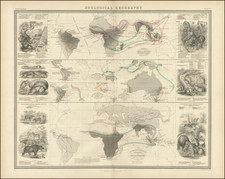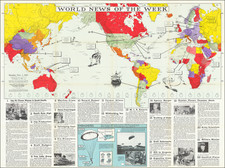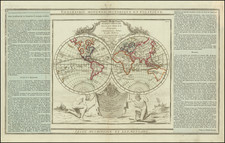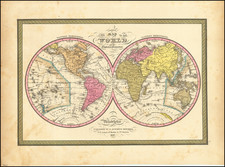Striking map of the world, published in Leipzig.
Translated from Latin, the title of the map boldly proclaims: "Globe of the Earth constructed from the most proven recent observations of geographers with the Copernican system and the Tychonic system and other phenomena." This elaborate title manifests the ambition and curiosity of the period, encapsulating the vigorous quest for knowledge that drove exploration and cartography in the 18th century.
The map presents a global perspective, detailing the continents of Europe, Africa, Asia, and the Americas, with inaccuracies reflecting the limited knowledge of remote lands such as Australia, yet undiscovered, and an optimistic hypothesis of a Northwest Passage in North America.
The map attempts a harmonization of the Copernican and Tychonic systems. The top and bottom center of the map is adorned with celestial diagrams depicting these two contrasting astronomical theories. The Copernican system, showing a heliocentric model, is diametrically opposed to the Tychonic model, which proposes a geocentric universe with the sun revolving around the Earth. These dueling cosmological systems represented on the map symbolize the transitional period between old and new worldviews.
"Terra Australis Incognita," is represented as a primitive landmass. Its edges are fringed with uncertainty, reflecting the incomplete understanding of this remote continent during the mid-18th century.
In North America, California is depicted as an imposing peninsula, a portrayal widely adopted in maps of the era. However, the map's greatest speculative venture is arguably the depiction of the Northwest Coast of America. This stretches ambiguously, either touching the edges of Asia or separated by a narrow, indistinct strip of ocean. This geographical guesswork hints at the existence of a Northwest Passage, the elusive sea route through the Arctic Ocean that had captivated and baffled explorers for centuries.
The southwestern Pacific introduces another element of conjecture, presenting a partial view of the western coast of New Zealand. Its fragmentary depiction reflects the limited knowledge gleaned from early encounters with this distant land. The voyages of Abel Tasman incompletely shape Australia.









